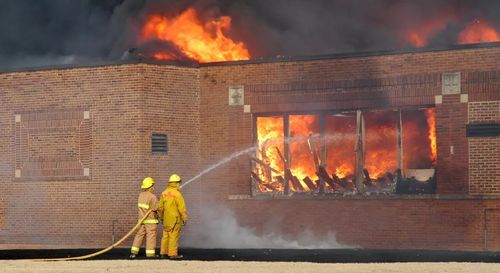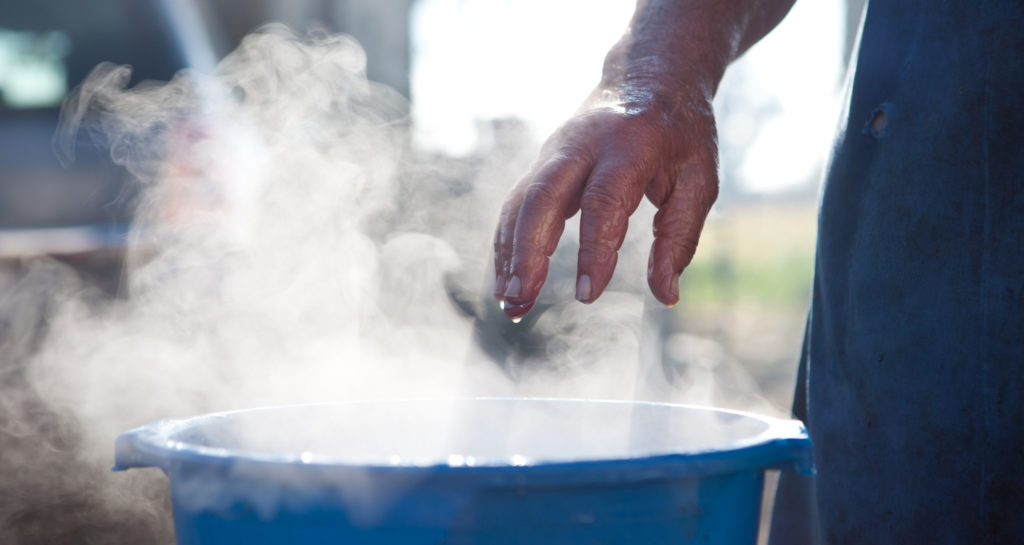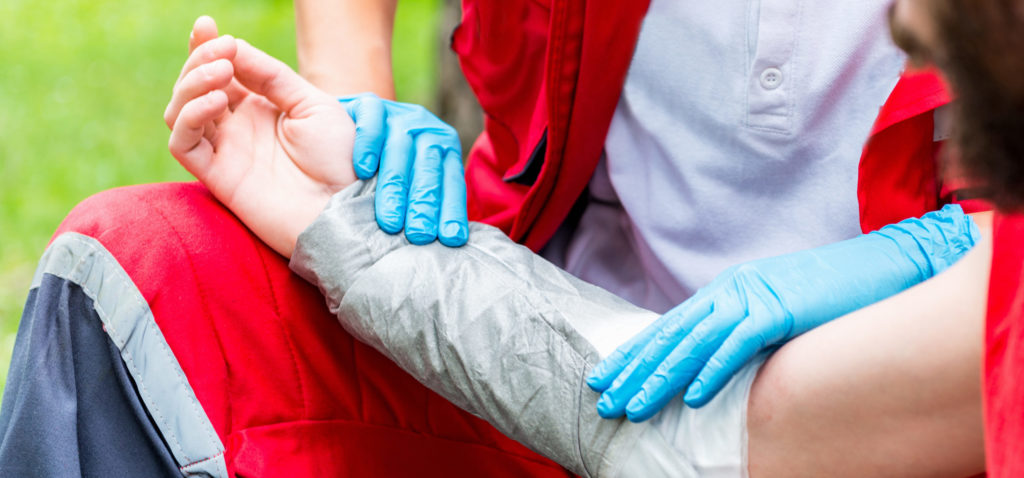You may be entitled to compensation if you suffered a burn injury in an incident caused by someone’s negligence. An experienced Charlotte burn injury lawyer can help you get your deserved compensation.

The North Carolina personal injury lawyers from Johnson & Groninger PLLC are available to provide the best possible representation for your claim. Continue reading to learn more about burn injuries. If you have any questions or are ready to speak with an attorney about your case, call us at (704) 200-2009.
Are there different types of burns?
A multitude of incidents may cause burn injuries, including car crashes, fires, or chemical exposure. There are also different types of burns, as we’ll explore below.
Chemical burns

Exposure to acids and alkalis can lead to significant burn injuries. Chemical burns can happen in lab accidents, from exposure to something as simple as battery acid, and even in car crashes. Chemical burns are widespread in the manufacturing and construction industries.
Electrical burns
Electrical burn injuries happen when the body makes direct or indirect contact with a “hot” or live electrical current. Electrical burns are especially dangerous as they can cause surface sharing, which can hide substantial internal damage below.
Thermal burns
Thermal burns include all burns caused by external heat sources such as house fires and scalding liquids. Direct contact with a source of extreme heat causes the temperature of the skin and tissues to rise, resulting in tissue death and skin charring.
Radiation burns
Radiation burns result from the body being exposed to high levels of radiation, which can include microwaves and other sources that are often found in manufacturing and construction.
What are the degrees of burns?
Burn injuries are categorized into “degrees.” The degree of the burn is based on how deep the burn has caused damage. Sometimes, the signs and symptoms of a severe burn can take a few days to develop.
That’s why it’s essential to seek prompt medical care after a burn injury to accurately identify the extent of the damage and get the proper treatment.
First-degree (superficial-thickness)
A first-degree burn damages only the epidermis, the outermost layer of your skin. This type of burn causes redness and pain but will generally go away. A typical example of a first-degree burn is a sunburn.
Second-degree (partial-thickness)
A second-degree burn causes damage to both the epidermis and the dermis, the second layer of skin. Second-degree burns can result in red, white, or splotchy skin, swelling, blisters, and extreme pain. Some second-degree burns may require skin grafts and can lead to permanent scarring.
Third-degree (full-thickness)
Third-degree burns are especially threatening to your health as they extend through the first and second layers of skin and impact the fat and other tissues below the skin. Skin damaged by a third-degree may appear black, brown, or white and look leathery.
Third-degree burns may destroy nerves, causing numbness. Third-degree burns are severe and should be treated immediately by a medical professional.
What are burn injury complications?
Because burn injuries can be very severe, might require ongoing treatment, and can lead to life-long disabilities, they can have a multitude of complications.
Fluid loss
A burn injury impacts the body’s self-regulating ability because the heat affects the tissue and capillaries. This can result in loss of vital fluids, including plasma, and can lead to low blood volume, magnifying the severity of the overall injury and its impact on health.
Infection
Bacterial infections are common because burn injuries are open wounds that can expose tissues, organs, and bones to the world. They can prevent the wound from healing or might require additional surgeries.
Hypothermia
Because the body is in shock and has a lesser ability to self-regulate, burns can lead to hypothermia.
Lung issues
Fires, steam burns, smoke inhalation, and inhaling chemicals can cause lung damage.
Bone or joint problems
Third-degree burns can descend into the bones and joints, leading to permanent issues with movement, resulting in disability.
Scars
Second-degree and deeper burns can lead to scarring, even without surgery or skin grafts.
Disfigurement
The scarring that results from a burn injury can be disfiguring. Injuries that result in disfigurement can impact quality of life and also require ongoing physical therapy and mental/psychological care to address the implications of the injury. These negative life changes are recoverable in damages.
What are the potential damages for a burn injury?
Damages are meant to make the injured party “whole” and put them in a financial position as close as possible to where they would be if the accident never happened. These damages will cover the costs associated with the burn injury, including medical bills, rehabilitation, and lost wages.
Being made “whole” also means getting compensation for losses that don’t automatically have a monetary value attached to them. Those losses include pain and suffering, loss of activities, loss of quality of life, scarring, and permanent injury, for example.
Medical bills and related expenses
Burn injuries can lead to significant medical costs both immediately after the incident and into the future. They sometimes require multiple surgeries, skin grafts, and rehabilitation.
These injuries often result in permanent scarring and mobility impairment, both of which can impact a patient’s quality of life. Damages will cover the costs you’ve already incurred and those expected to occur throughout your life.
Lost wages and loss of earning potential
Burn injuries can require lengthy recovery periods and can cause partial or permanent disability, all of which might limit your ability to work in the same capacity or might cause you to miss work or stop working altogether. You’re entitled to the value of any lost wages and work benefits like accrued sick and vacation time while recovering from your injury.
If your burn injury changes your ability to work in the long term, you could also be entitled to any loss or decrease in your earning potential. These damages require more work to prove than medical costs, but an experienced Charlotte burn injury lawyer can help you receive what you deserve.
Property loss
If your property was damaged due to the accident or incident, you are entitled to the fair market value of any lost property or belongings. For example, if you were in an accident caused by a negligent person and your car caught fire, you are entitled to the fair market value of your vehicle to assist you in replacing it.
Pain and suffering
You also are entitled to damages for the pain and suffering and even emotional distress you’ve suffered as a result of your burn injury. This can include psychological conditions that arise following the accident, such as post-traumatic stress, sleeplessness, fear, or anxiety.
Punitive damages
Punitive damages differ from those above, all considered “compensatory damages.” Punitive damages aren’t based on or calculated by the loss suffered by the victim. Instead, they’re intended to punish the at-fault party to deter them and others who might repeat the action(s) that caused your injury.
Punitive damages are only available in certain circumstances in North Carolina’s punitive damages statute.
Why hire a lawyer after being burned?
When your burn injury was caused by someone or something else, you’ll need to file a claim with the at-fault party’s insurance company to collect your damages, which sometimes requires a lawsuit. You’ll also need to collect necessary evidence and seek appropriate medical care, including follow-up care, to prove your injuries and the damages you request.
It sometimes requires meticulous work to identify the appropriate insurance company (or companies) you must contact and where or how to file your claim. Patients may also find it challenging to find the best places to receive the care they need and know what evidence to collect.
Our team of Charlotte personal injury lawyers is highly experienced in pursuing the correct insurance companies and presenting all the evidence to ensure our clients collect the damages they deserve.
Best burn treatment centers in North Carolina
There are two burn treatment centers in North Carolina where you can receive top-notch care for your burn injury:
- UNC Jaycee Burn Center also has a specialty clinic for pediatric burn care because pediatric burns are some of the most common injuries experienced among children. Younger children commonly suffer from scald burns, whereas older children are likelier to experience contact burns.
- Atrium Health Wake Forest Baptist is slightly smaller than UNC. Still, their treatment and care are no less excellent, including burn-dedicated ICU and acute care units, hydrotherapy areas, and long-term individual units.
How a Charlotte burn injury lawyer from Johnson & Groninger PLLC can help
Working with an experienced Charlotte burn injury lawyer to collect evidence, draft your claim, and negotiate a settlement or take the insurance company to court is the best way to get the best possible outcome from such an awful situation.
The experienced NC personal injury attorneys at Johnson & Groninger PLLC will investigate your claim to discover all potentially liable parties and the full extent of your damages. If you suffered a burn injury caused by someone or something else, don’t wait to contact us because you have limited time to file your claim.
Call us at (704) 200-2009 or online to schedule your consultation.
 Call Us 919-240-4054
Call Us 919-240-4054




